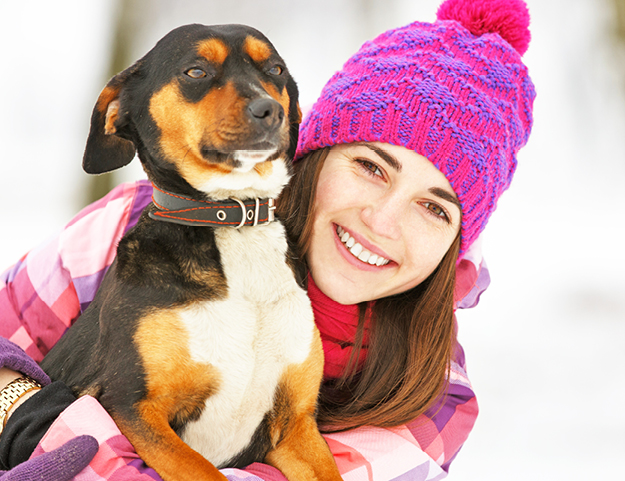Q: I know humans can get the flu and you should get a flu shot when the winter approaches. Are my dogs at risk for getting the flu also?
A: What a great question! Yes, indeed your dog can get the flu. It is not the same flu that people get but it is very contagious nonetheless. You may have heard about the outbreak of flu in Chicago last winter- those poor puppies were miserable! They had horrible nasal discharge, sneezing and coughing, and many of them had fevers and wouldn’t eat. They had to shut down all the dog parks and shelters to get rid of it. There are actually two types of flu but your veterinarian at Sugar Hill has a vaccine that will protect against both of them. It is really easy to be protected and then you don’t have to worry about all the friends you meet at the park.
Q: Is it OK to walk my dog when it’s cold outside and even if it’s snowing?
Many dog owners live with the misconception that because their pets have a coat of fur, they can tolerate the cold better than humans. This isn’t necessarily the case. If it’s too cold for you to stand at the door without your coat, it’s probably too cold for your dog too, so pay attention to his behavior while he’s outdoors.
If you notice your dog whining, shivering or appearing anxious, or he stops playing and seems to be looking for places to burrow, then it’s time to bring him in. Frostbite begins when the dog’s body gets cold. The body automatically pulls blood from the extremities to the center of the body to stay warm. The dog’s ears, paws or tail can get so cold that ice crystals can form in the tissue and damage it. The tricky thing to remember about frostbite is that it’s not immediately obvious. Watch for signs of pale or grey skin; the skin may also turn hard and cold. As frostbitten areas warm, they can be extremely painful. Severely frostbitten skin will eventually turn black and slough off. A second serious winter weather concern is hypothermia. This occurs when a dog spends too much time in the cold, gets wet in cold temperatures or when dogs with poor health or circulation are exposed to cold. In mild cases, the dog will shiver; ears and feet may grow cold. As hypothermia progresses, she may show signs of depression, lethargy, and weakness. As the condition worsens, her muscles will stiffen, her heart and breathing rates slow down, and she will not respond to stimuli. Severe hypothermia is life threatening. Preventing your dog from frostbite and hypothermia is essential, so learn how to recognize the signs that your dog needs to come indoors to warm up.

Dr. Hamryka is the Owner and Medical Director of Sugar Hill Animal Hospital. His special interests include geriatrics and orthopedics.
Ask Henry at sugarhillanimalhospital.com.

















